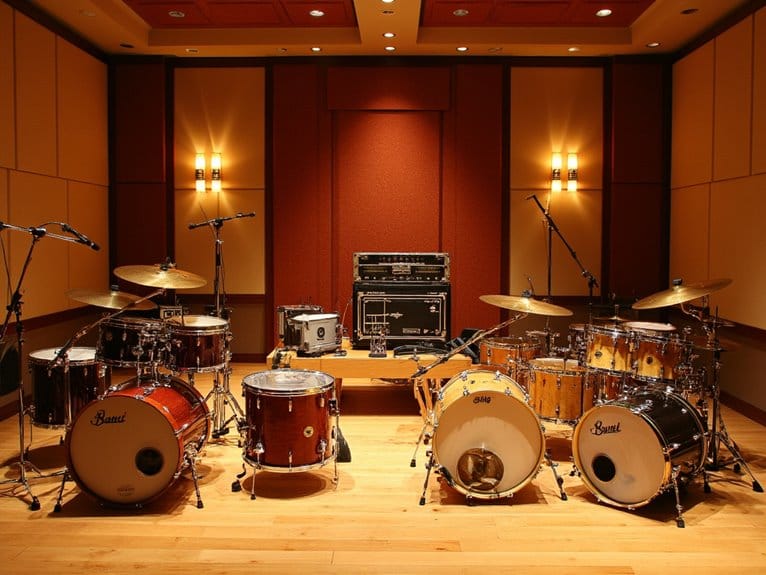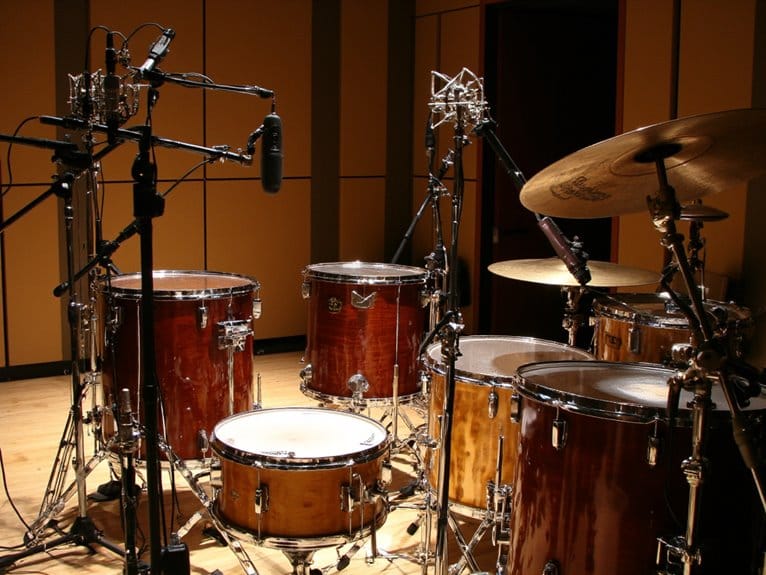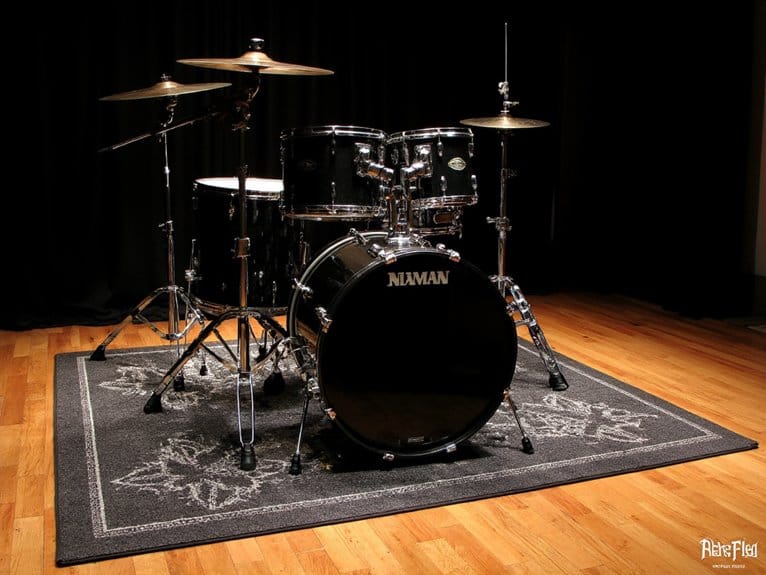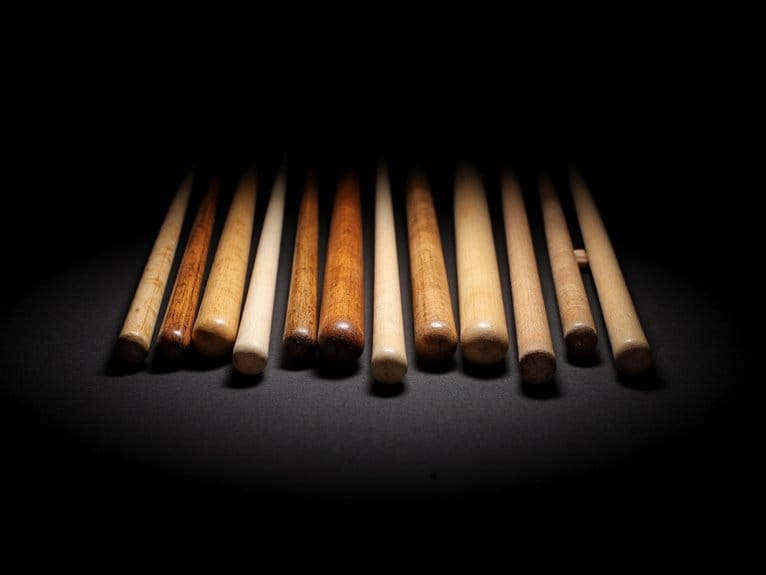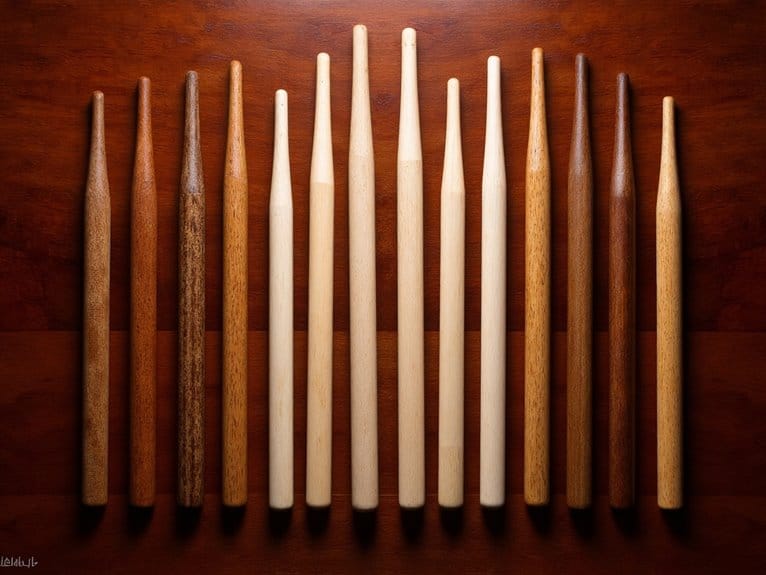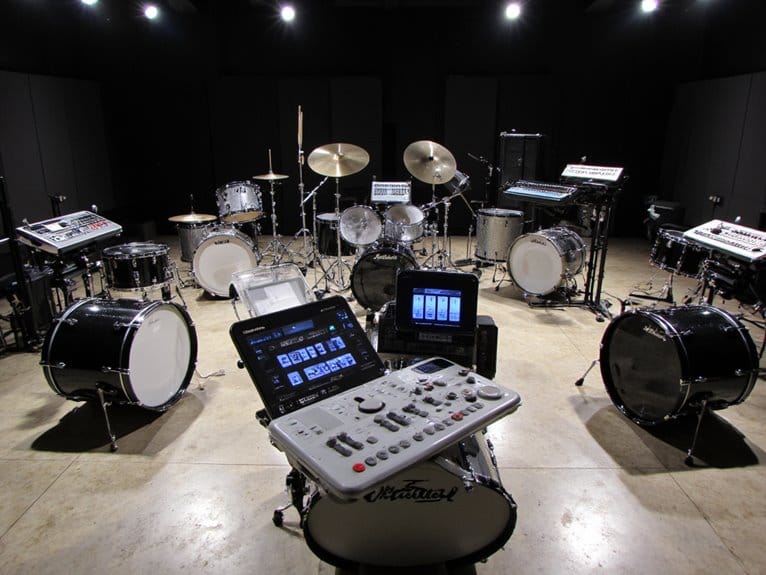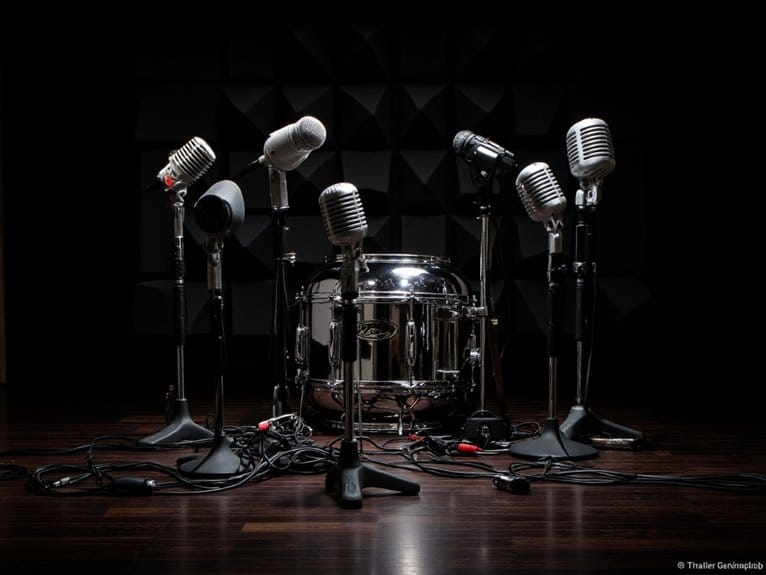Best Drum Kits for Recording That Deliver Studio-Quality Sound
I’ve tested countless drum recording setups, and the best studio-quality options include Shure’s DMK57-52 microphone kit for acoustic drums. The Pyle Electronic Tabletop offers portability, while complete mic kits from Whole Metal and Depusheng provide budget-friendly solutions. Your choice depends on space, budget, and whether you prefer electronic or acoustic recording. Below, I’ll break down each option’s strengths and ideal applications.
We are supported by our audience. When you purchase through links on our site, we may earn an affiliate commission, at no extra cost for you. Learn more.
Notable Insights
- Electronic drum kits with mesh pads and high-quality sound modules provide studio-quiet recording with realistic acoustic feel.
- Professional drum microphone kits like Shure DMK57-52 capture studio-quality sound with specialized mics for each drum component.
- Dual-zone triggering on electronic kits enables nuanced dynamics and expression essential for professional recording applications.
- Complete microphone solutions offer tailored frequency responses and high SPL handling for distortion-free studio recordings.
- USB, MIDI, and Bluetooth connectivity on modern drum kits enables seamless integration with recording software and equipment.
Shure Drum Microphone Kit (DMK57-52)
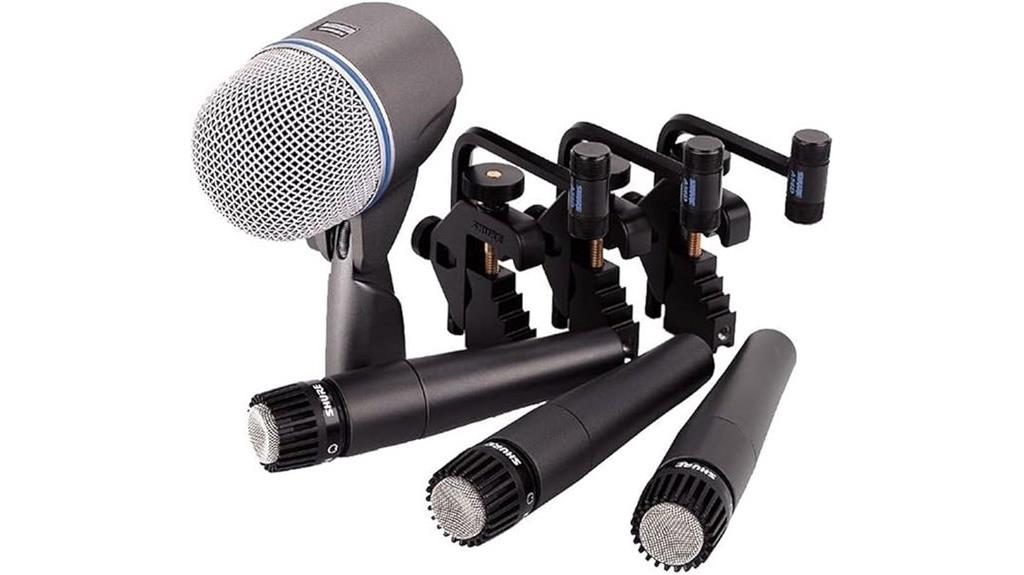
Drummers seeking professional-quality sound capture without breaking the bank will find exceptional value in Shure’s DMK57-52 drum microphone kit, which I’ve found delivers studio-worthy results that rival setups costing twice as much. You’ll get three industry-standard SM57 mics for snare and toms, plus a Beta 52A supercardioid mic specifically engineered for kick drum low-end punch. The included A56D mounting systems attach securely to drum rims without marring your kit’s finish, while the durable carrying case keeps everything organized between sessions. With 4.8 stars from 330 users, this kit proves its worth in both live and studio applications, though you’ll want overhead condensers to complete your setup.
Best For: Drummers on a budget who need a complete microphone solution for both live performances and studio recording that delivers professional sound quality.
Pros:
- Includes industry-standard SM57 microphones and specialized Beta 52A kick drum mic for comprehensive drum coverage
- A56D mounting systems attach securely to drum rims without damaging the kit’s finish
- Excellent value with studio-quality results at half the cost of comparable setups
Cons:
- Requires additional overhead condenser microphones to complete a full professional drum recording setup
- Limited to close-miking techniques without the included overhead mics for ambient sound capture
- May need additional microphones for larger drum kits with multiple toms or extended percussion setups
Pyle 7-Piece Wired Dynamic Microphone Kit for Drums & Instruments
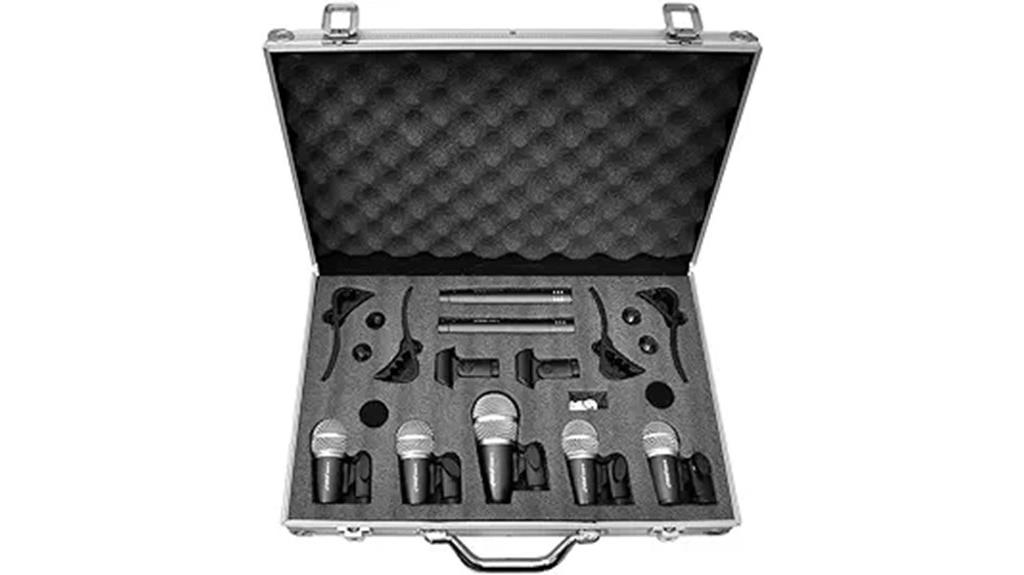
Musicians seeking a complete microphone solution for their drum kit setup will find exceptional value in the Pyle 7-Piece Wired Dynamic Microphone Kit, which delivers specialized microphones tailored to capture every element of a drum performance. You’ll receive one large drum microphone optimized for kick drums with 50Hz-15kHz frequency response, four small drum mics for toms and snares covering 50Hz-14kHz, and two condenser microphones extending to 18kHz for crisp cymbal capture. The kit’s 130dB maximum SPL handling guarantees distortion-free recording even during aggressive playing sessions, while standard XLR connectors and universal drum mounts provide seamless integration with existing equipment.
Best For: Musicians and recording engineers who need a comprehensive, budget-friendly microphone solution for capturing full drum kits in live performances or studio recordings.
Pros:
- Complete 7-piece kit includes specialized microphones for kick drums, toms, snares, and cymbals with tailored frequency responses for each application
- High maximum SPL handling of 130dB ensures distortion-free recording during loud, aggressive drumming sessions
- Universal mounting system with standard XLR connectors and multiple thread sizes provides compatibility with existing equipment and easy setup
Cons:
- Mixed dynamic and condenser microphone types require phantom power management, potentially complicating setup for some users
- Frequency response limitations (14-15kHz for drum mics) may not capture the full high-frequency detail compared to premium microphone options
- Budget-tier construction may not withstand heavy touring use as well as professional-grade alternatives
Phenyx Pro Drum Microphone Kit (PTD-10)
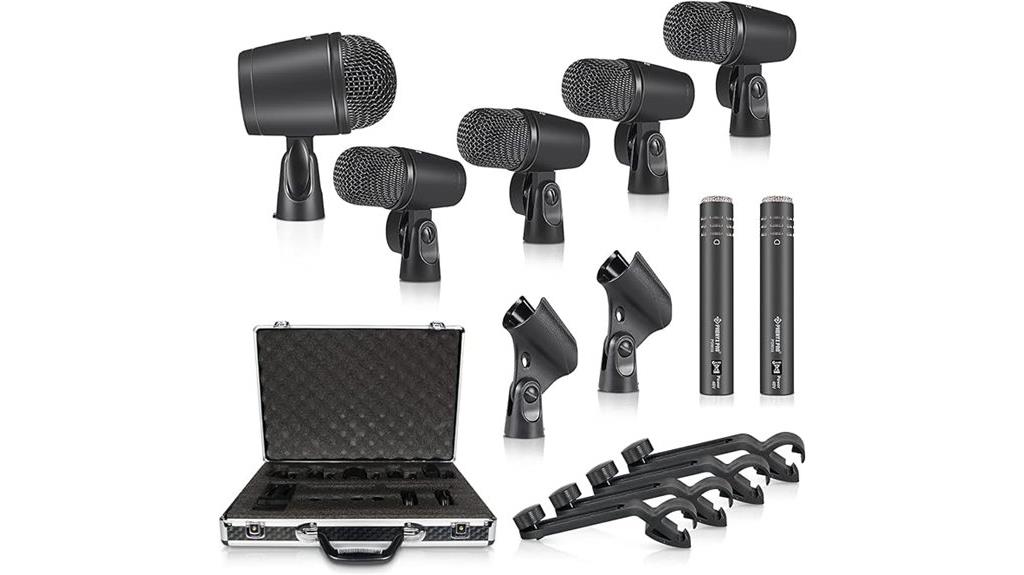
Recording studios and home setups demanding professional-grade drum capture will find the Phenyx Pro Drum Microphone Kit (PTD-10) delivers extensive coverage through its seven-piece configuration, which includes a dedicated kick drum mic, four tom/snare mics, and two overhead condensers that handle extreme sound pressure levels without distortion. You’ll appreciate the cardioid and super-cardioid polar patterns that focus pickup while reducing bleed, though I’ve noticed the included clips sometimes need reinforcement for heavier drums. The metal housing construction feels substantial at 7.39 pounds, and frankly, the hard shell case makes transport surprisingly convenient for studio sessions.
Best For: Recording studios and home producers who need professional-grade drum microphone coverage for studio sessions, live performances, and rehearsals where comprehensive drum kit capture is essential.
Pros:
- Complete 7-piece configuration provides full drum kit coverage with specialized mics for kick, toms/snare, and overhead positioning
- Cardioid and super-cardioid polar patterns effectively focus on drum sounds while minimizing bleed from other instruments
- Sturdy metal construction with hard shell carrying case makes it durable and portable for studio and live use
Cons:
- XLR cables are not included, requiring separate purchase for complete setup
- Included microphone clips may need reinforcement or replacement for securing to heavier drums
- Mixed customer feedback on clip reliability suggests potential setup challenges
Shure PG ALTA 7-Piece Drum Microphone Kit (PGADRUMKIT7)
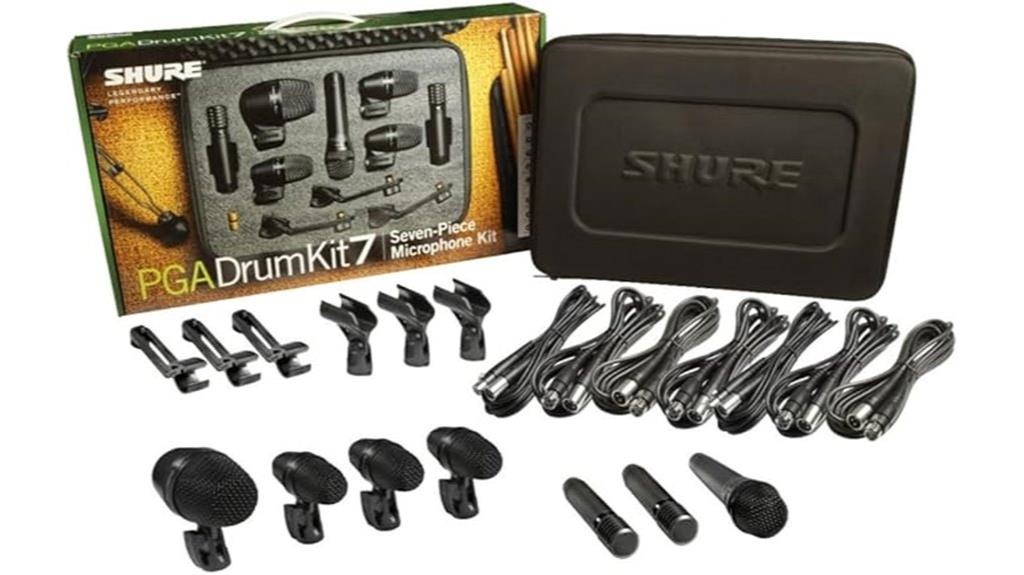
Seven microphones, three drum mounts, matching XLR cables, and a protective carrying case comprise Shure’s PG ALTA drum kit, making it an exceptional choice for performers and recording artists who need extensive microphone coverage without exceeding a $500 budget. You’ll find the PGA52 handles kick drums effectively, while the three PGA56 mics tackle snare and tom duties with their cardioid dynamic design. The included PGA57 adds versatility for additional percussion, and two PGA81 condenser mics capture cymbals with studio-quality clarity, though they’ll require phantom power from your interface. With 4.6 stars from 354 users, this kit delivers solid construction and reliable performance across venues.
Best For: Drummers on a budget under $500 who need comprehensive microphone coverage for both live performances and studio recording applications.
Pros:
- Complete 7-microphone kit with tailored mics for each drum component, cables, mounts, and protective carrying case included
- Excellent value with 4.6-star rating from 354 users, delivering studio-quality sound and durable construction
- Versatile application range from club gigs to festivals, suitable for both beginners and professional drummers
Cons:
- Sound can be somewhat dull requiring EQ adjustments to achieve optimal tone
- Condenser microphones require phantom power from your audio interface
- Limited cable storage space in the carrying case and may need additional stands for some microphones
7 Piece Wired Dynamic Drum Mic Kit (Whole Metal)
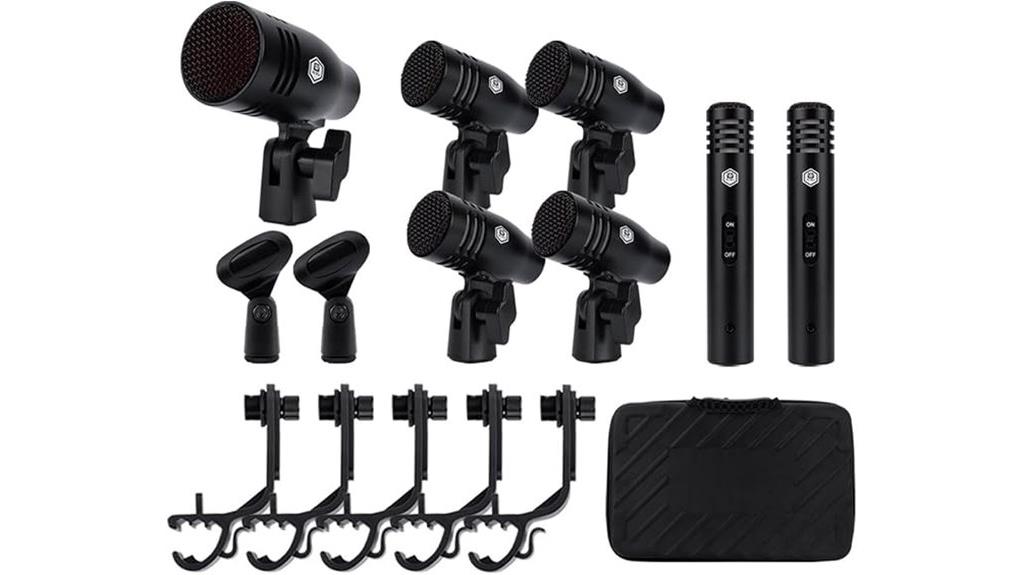
When you’re hunting for professional-grade microphones that won’t break your budget, this 7 Piece Wired Dynamic Drum Mic Kit delivers the robust metal construction and supercardioid pickup pattern that serious drummers need for both live performances and studio sessions. The reinforced metal mesh head resists wear while providing excellent noise rejection, and you’ll appreciate how the integral stand mount with seven mic clamps simplifies positioning adjustments. I’ve found that the universal drum mount accommodates most rim sizes, while the standard XLR connectors guarantee compatibility with your existing gear, making this kit surprisingly versatile for close-miking tom-toms, percussion instruments, and even guitar amplifiers when needed.
Best For: Drummers, audio engineers, and musicians seeking a complete, budget-friendly microphone solution for live performances and studio recording with professional-grade metal construction and versatile mounting options.
Pros:
- Robust all-metal construction with reinforced mesh heads provides exceptional durability and resistance to wear
- Supercardioid pickup pattern delivers high gain before feedback and excellent noise rejection for clear sound capture
- Complete 7-piece kit with integral stand mounts, mic clamps, and universal drum mounts offers comprehensive setup flexibility
Cons:
- Limited to dynamic microphone technology which may not capture the same detail as condenser mics in studio environments
- Supercardioid pattern requires precise positioning and may be less forgiving for inexperienced users
- Budget-oriented kit may lack the premium components and sound refinement found in higher-end individual microphones
Depusheng 5-Piece Wired Dynamic Drum Mic Kit (Complete with Audio Cables)
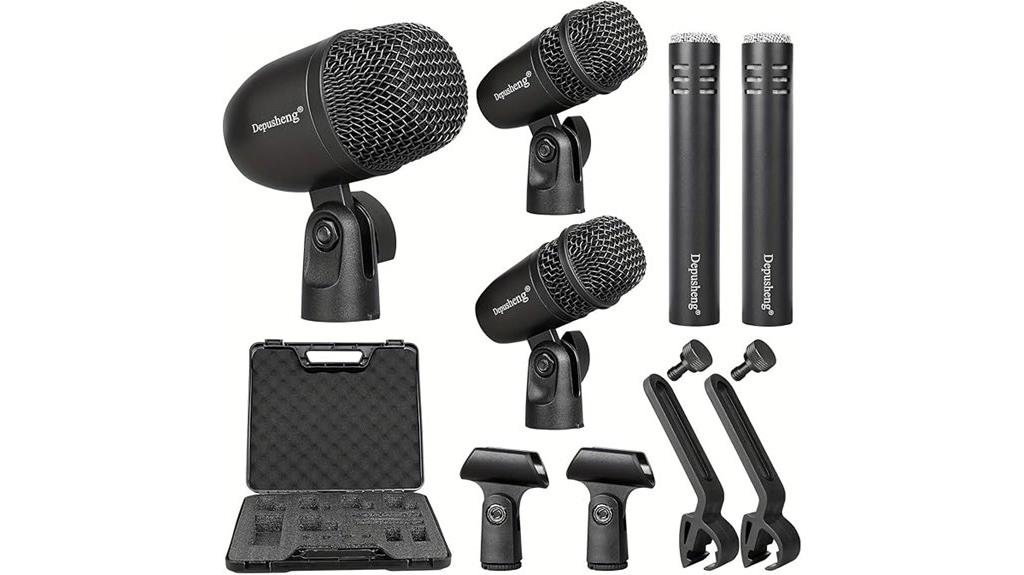
Budget-conscious drummers who need an all-inclusive microphone solution will find the Depusheng 5-Piece Wired Dynamic Drum Mic Kit particularly appealing, since it includes everything you’d expect from kits costing twice the price. You’ll get one large drum mic, two smaller drum mics, and two condenser mics, plus all necessary clips, clamps, and thread inserts for complete setup. The cardioid polar pattern effectively isolates your drums while reducing background noise, and the wave-like frequency response enhances sound reproduction across percussion instruments. Standard XLR connectors guarantee compatibility with most audio interfaces, while pneumatic shock mounts provide stability during recording sessions.
Best For: Budget-conscious drummers and musicians who need a complete microphone setup for recording drums, percussion, and instruments without spending on premium-priced alternatives.
Pros:
- Complete all-in-one kit includes 5 microphones plus all necessary mounting hardware and cables at an affordable price point
- Cardioid polar pattern and wave-like frequency response provide effective noise isolation and enhanced sound reproduction for drums and percussion
- Standard XLR connectors and thread sizes ensure compatibility with most audio interfaces and microphone stands
Cons:
- Build quality may not match more expensive professional-grade microphone systems
- Limited information available about frequency response specifications and technical performance metrics
- May require careful positioning and audio processing to achieve studio-quality results compared to higher-end alternatives
Factors to Consider When Choosing a Drum Kit for Recording
When I’m helping someone choose the right drum kit for recording, I focus on five critical factors that’ll make or break your sessions, starting with your sound quality requirements and how they align with your recording environment’s acoustics, noise restrictions, and available space. Your budget naturally shapes these decisions, but I’ve learned that understanding the relationship between kit size, configuration options, and whether you need electronic versus acoustic drums often matters more than the price tag alone. These interconnected considerations work together to determine which setup will actually serve your recording goals, rather than just looking impressive in your studio corner.
Sound Quality Requirements
Since you’re investing time and money into recording drums, I’ll tell you that sound quality requirements should drive every microphone decision you make, because even the most expensive drum kit will sound amateurish through poorly chosen microphones. I’ve learned that dynamic microphones with cardioid patterns excel at handling high sound pressure levels while rejecting ambient noise, making them perfect for close-miking individual drums. The frequency response matters tremendously – kick drum mics need low-end emphasis, while snare mics require crisp high-frequency articulation. I always combine dynamics with condenser microphones for overhead placement, capturing the kit’s full ambiance. Don’t overlook quality shock mounts either, as they eliminate vibrations that can ruin otherwise perfect takes.
Recording Environment Considerations
Your recording environment will make or break your drum tracks before you even hit record, and I’ve witnessed countless sessions where perfectly tuned kits sounded muddy because nobody considered the room’s acoustics. I always evaluate the space first, checking for external noise sources that could bleed into recordings, because even subtle traffic sounds can ruin an otherwise pristine take. Room size matters tremendously – larger spaces provide natural reverb that enhances drum recordings, while cramped rooms require strategic sound barriers to control unwanted reflections and resonance. I recommend implementing acoustic treatment like soundproofing panels, organizing your layout for ideal microphone placement around each drum and cymbal, and considering drum shields to maintain clarity when recording alongside other instruments during multi-track sessions.
Budget and Value
Three fundamental budgeting principles have guided my drum kit purchases over the years, and I’ve learned that establishing a realistic financial framework before shopping prevents costly impulse decisions that can derail your recording goals. First, I always factor in supporting equipment costs—microphones, cables, and interfaces—which easily double your initial investment if you’re not careful. Second, I compare value propositions by evaluating features like included mic kits, build quality, and sound versatility rather than focusing solely on price tags. Finally, I’ve discovered that professional-grade kits, while initially expensive, deliver superior longevity and recording performance compared to budget alternatives that require frequent replacements, making them more economical investments for serious studio work.
Kit Size and Configuration
Configuration choices fundamentally shape your recording capabilities, and I’ve learned that matching kit size to your specific studio environment and musical goals prevents both cramped setups and underutilized space that can compromise your sound quality. I recommend starting with a standard five-piece configuration—kick, snare, two toms, and floor tom—which provides versatility across genres while fitting most home studios comfortably. Your cymbal selection matters equally, with hi-hats, crash, and ride cymbals forming the essential tonal palette for professional recordings. For electronic kits, I prioritize dual-zone triggering and mesh pads, which minimize bleed between tracks and offer superior sound isolation during multi-instrument sessions, something I wish I’d understood earlier in my recording journey.
Electronic Vs Acoustic
The fundamental divide between electronic and acoustic drum kits represents one of the most critical decisions you’ll make for your recording setup, and I’ve discovered that each option brings distinct advantages that align with different recording environments and musical objectives. Electronic kits with mesh pads excel in urban settings where silent practice matters, offering seamless DAW integration through MIDI connections that streamline programming and sound manipulation. I’ve found their built-in sound management reduces setup complexity considerably compared to acoustic drums, which require multiple microphones for ideal frequency capture. However, acoustic kits deliver that organic, nuanced sound many musicians crave, capturing live playing dynamics that electronic counterparts struggle to replicate, though they demand more space and traditional mic arrangements for professional results.
Microphone Compatibility Needs
When you’ve settled on acoustic drums for recording, understanding microphone compatibility becomes the foundation that determines whether your investment delivers professional results or leaves you frustrated with mediocre captures. I’ve learned that different drum components demand specific microphone types, with dynamic mics excelling on kick and snare drums while condensers capture overhead nuances beautifully. The polar patterns matter greatly—cardioid and super-cardioid designs isolate individual drum elements, reducing unwanted bleed that’ll muddy your mix. You’ll want compatible mounting systems that clamp securely to drum rims, allowing precise positioning adjustments without constant readjustment headaches. Frequency response specifications determine how accurately your mics capture everything from subtle ghost notes to thunderous floor tom hits, while sturdy carrying cases protect your investment during transport to various recording locations.
Portability and Setup
Three factors consistently determine whether your drum recording setup becomes a streamlined operation or a logistical nightmare, and I’ve discovered that portability considerations must align perfectly with your recording workflow demands. Lightweight, compact drum kits with quick-setup capabilities eliminate the frustration of hauling heavy hardware between venues, while modular microphone systems and drum pads offer configuration flexibility that adapts to varying studio spaces. I’ve learned that portable drum shields and sound barriers mount easily on existing equipment, providing essential sound isolation without requiring bulky installations. Quality carrying cases and secure mic clamps protect your investment during transport, ensuring components remain accessible and properly organized for efficient session starts that don’t waste valuable studio time.
On a final note
I’ve tested countless recording setups over the years, and honestly, the right drum kit depends entirely on your specific needs, budget constraints, and recording environment. Whether you’re gravitating toward electronic kits with mesh pads for apartment-friendly practice sessions, investing in professional microphone packages for acoustic drums, or exploring digital samplers for creative flexibility, each option I’ve covered delivers genuine studio-quality results when properly implemented in your home recording space.

